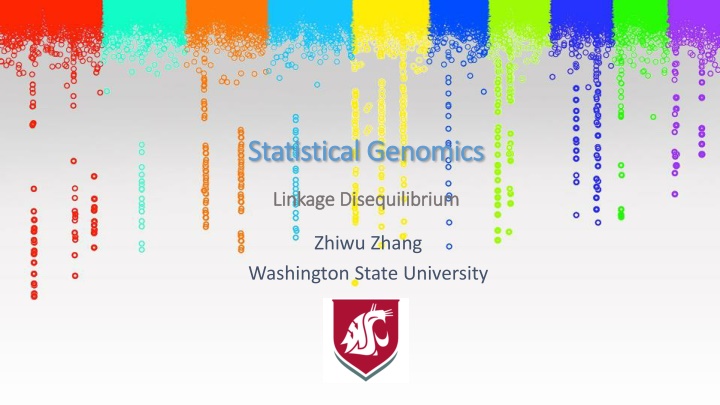
Linkage and Disequilibrium in Statistical Genomics
Explore the concepts of linkage and disequilibrium in statistical genomics, covering the Hardy-Weinberg principle, association analysis, and the Hardy-Weinberg equilibrium. Learn about allele and genotype frequencies, haplotype frequencies, and the quantification of linkage disequilibrium.
Download Presentation

Please find below an Image/Link to download the presentation.
The content on the website is provided AS IS for your information and personal use only. It may not be sold, licensed, or shared on other websites without obtaining consent from the author. If you encounter any issues during the download, it is possible that the publisher has removed the file from their server.
You are allowed to download the files provided on this website for personal or commercial use, subject to the condition that they are used lawfully. All files are the property of their respective owners.
The content on the website is provided AS IS for your information and personal use only. It may not be sold, licensed, or shared on other websites without obtaining consent from the author.
E N D
Presentation Transcript
Statistical Genomics Statistical Genomics Linkage Linkage Disequilibrium Disequilibrium Zhiwu Zhang Washington State University
Outline Hardy-Weinberg principle LD measurements D D R2 Causes of LD LD decay
Association analysis Marker AA aa SUM Herbicide Resistant (BB) 35 5 40 Observed Non herbicide Resistant (bb) 35 25 60 SUM 70 30 100 Marker AA aa SUM Herbicide Resistant (BB) 28 12 40 Expected Non herbicide Resistant (bb) 42 18 60 SUM 70 30 100 49/28+49/12+49/42+49/18=9.72 1-pchisq(9.72,1) 0.0018
The HardyWeinberg (HD) principle Allele and genotype frequencies in a population will remain constant from generation to generation in the absence of other evolutionary influences. These influences include non-random mating, mutation, selection, genetic drift, gene flow and meiotic drive. Allele frequency: f(A)=p, f(a)=q Genotype frequency: f(AA)=p2, f(aa)=q2, f(Aa)=2pq Both allele and genotype frequency remain unchanged: Hardy- Weinberg equilibrium
HD principle for two loci First locus: A and a alleles; Second locus: B and b alleles Allele frequency: PA+Pa = 1, PB+Pb=1 Haplotype frequency: PAB=PAPB, Pab=PaPb, so on so forth Haplotype frequency reaches the equilibrium stage with one generation of random matting if the two loci are on different chromosomes It takes multiple generation to reach the the equilibrium stage if the two loci are on the same chromosome It takes more generation to move out the linkage disequilibrium stage with lower recombination rate between the two loci
Linkage equilibrium and Disequilibrium Linkage equilibrium: haplotype frequencies in a population have the same value that they would have if the genes at each locus were combined at random. Linkage disequilibrium: Non-random association of alleles at different loci in a given population
Linkage Disequilibrium Quantification Linkage equilibrium: PAB=PAPB D(ifference)=PAB-PAPB= 0 ?? ??????????? ??? ???? ?? ??????????????
Linkage Disequilibrium (LD) Loci and allele A a B b Frequency .6 .4 .7 .3 Gametic type AB Ab aB ab Observed 0.5 0.1 0.2 0.2 Frequency equilibrium 0.42 0.18 0.28 0.12 Difference 0.08 -0.08 -0.08 0.08 D = PAB-PAPB =-(PAb-PAPb) =Pab-PaPb =-(PaB-PaPB )
Lemma D=PABPab-PAbPaB Proof (1): PABPab=(PAPB+D) (PaPb+D)= PAPB PaPb + PAPB D + PaPb D + D2 (2): PAbPaB=(PAPb-D) (PaPB-D)= PAPb PaPB - PAPb D - PaPB D + D2 Subtracting (2) from (1): PABPab-PAbPaB=D(PAPB + PaPb + PAPb + PaPB )=D 1
D depends on allele frequency Vary even with complete LD PAb=PaB=0 PAB=1-Pab=PA=PB D=PA-PAPA
Property of D Deviation between observed and expected Extreme values: -0.25 and 0.25 Non LD (equilibrium): D=0 Dependency on allele frequency
Modification of D: D Lewontin (1964) proposed standardizing D to the maximum possible value it can take: D =D/DMax Dmax: = max( PAPB, PaPb) if D<0 min(PAPb, PaPB) ?? ? > 0 Range of D : 0 to 1
Example Loci and allele A a B b Frequency .6 .4 .7 .3 Gametic type AB Ab aB ab Observed 0.5 0.1 0.2 0.2 Frequency equilibrium 0.42 0.18 0.28 0.12 Difference 0.08 -0.08 -0.08 0.08 D =PAB-PAPB = 0.08 Dmax=min (PAPb, PaPB) =min(.6x.3, .4x.7) =0.18 D =D/Dmax=0.08/0.18 =0.44
No effect by switching A to a Loci and allele a A B b Frequency .6 .4 .7 .3 Gametic type aB ab AB Ab Observed 0.5 0.1 0.2 0.2 Frequency equilibrium 0.42 0.18 0.28 0.12 Difference 0.08 -0.08 -0.08 0.08 D =PAB-PAPB = -0.08 Dmax=max (-PAPB, -PaPb) =max(-.4x.7, -.6x.3) =-0.18 D =D/Dmax=-0.08/-0.18=0.44
R2 Hill and Robertson (1968) proposed the following measure of linkage disequilibrium: r2 ( 2)=D2/(PAPBPaPb) Square makes positive The product of allele frequency creates penalty for 50% allele frequency. Range: 0 to 1
Summary of LD statistics R2 P values D D D2/(PAPBPaPb) Definition Statistical test (e.g. X2) 1 PAB-PAPB D/DMax Value at equilibrium 0 0 0 Value at complete LD Disadvantage 0 -0.25 or 0.25 1 1 Dependency on allele frequency Penalty on neutral loci
Causes of LD Linkage Mutation Selection Inbreeding Genetic drift Gene flow/admixture True association Spurious association
Mutation and selection Generation 1 A____q A____Q A____q mutation A____q A____q A____q A____q Generation 2 A____q A____Q A____Q A____q Selection A____q A____q Generation 3 A____Q A____Q A____Q A____q Selection A____Q A____q
Change in D over time c: recombination rate Dt=D0(1-c)t t=log(Dt/D0)/log(1-c) if c=10%, it takes 6.5 generation for D to be cut in half 1Mb=1cM, if two SNPs 100kb apart, c=1% / 10 = 0.001 It takes 693 generations for D to be cut in half
Change in D over time 0.25 0.20 c=.01 0.15 Dt 0.10 c=.05 0.05 c=.1 c=.25 0.00 0 10 20 30 40 50 t
Human out of Africa https://arstechnica.com/science/2015/12/the-human-migration-out-of-africa-left-its-mark-in-mutations/
HW equilibrium, Linkage equilibrium and Linkage disequilibrium LE LD HWE PAA=P2 Single locus Association LD Decay Multiple locus PAB=PAPB PAB=PAPB PAB!=PAPB Same chromosome different chromosome
Highlight Trait-marker association Hardy-Weinberg principle Linkage an recombination LD measurements D D R2 Causes of LD LD decay
